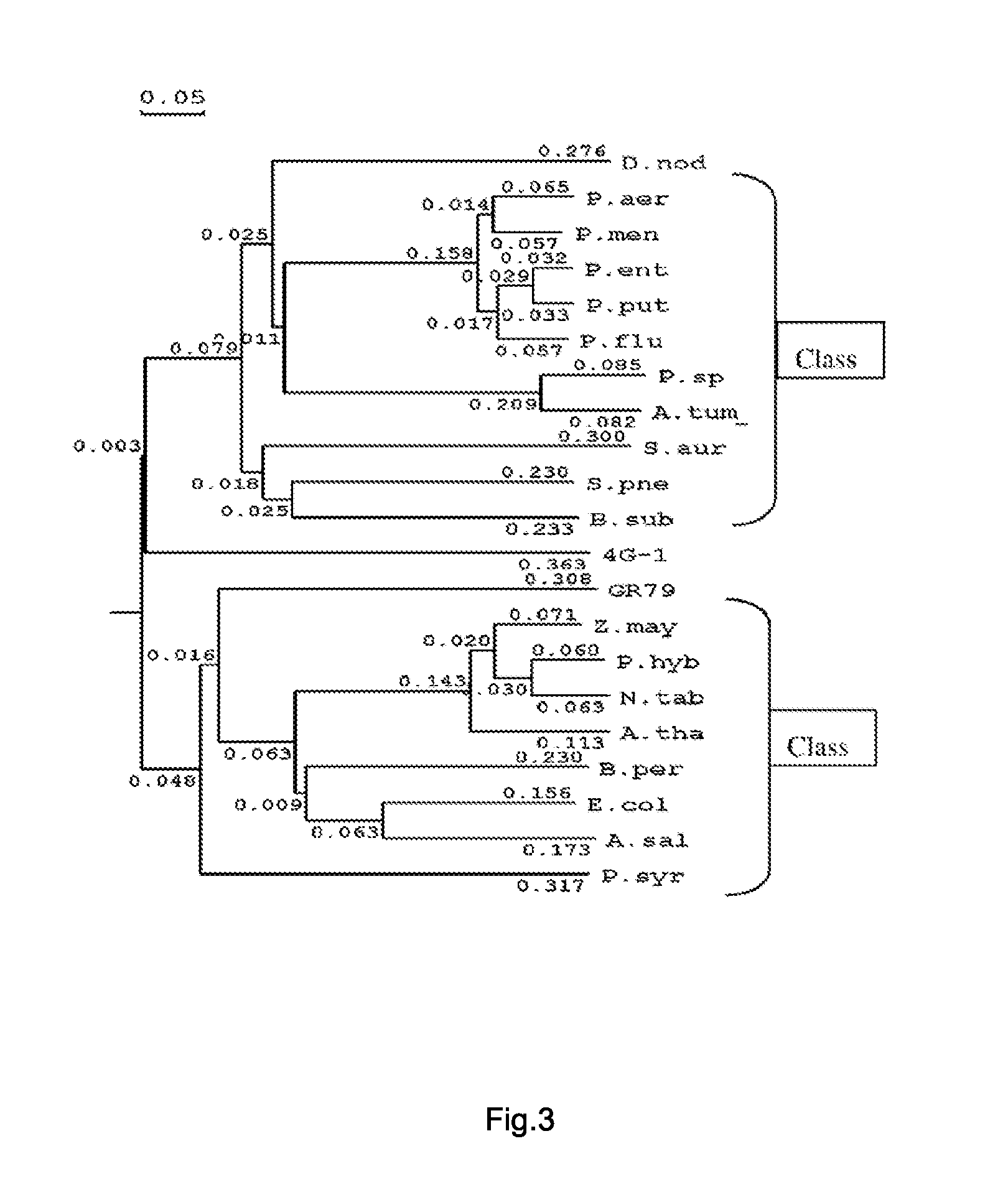EPSP synthase with high glyphosate resistance and its encoded sequence
a synthase and glyphosate technology, applied in the field of new epsp synthase (5enolpyruvylshikinate3phosphate synthase), can solve the problems of killing the crop as well, and achieve the effect of strong affinity to glyphosate and high glyphosate resistan
- Summary
- Abstract
- Description
- Claims
- Application Information
AI Technical Summary
Benefits of technology
Problems solved by technology
Method used
Image
Examples
example 1
Cloning of DNA Fragment with High Glyphosate Resistance
[0034]1. Collecting the Samples from the Soil Extremely Contaminated with Glyphosate
[0035]The samples were collected from the soil contaminated with about 50% glyphosate for more than 10 years (in a certain chemical industrial Co., Ltd in Hebei, China).
2. Isolation of Total DNA at the Community Level from the Soil Extremely Contaminated with Glyphosate Using Free Culturing Method
[0036]2 g of the soil were weighted and added with 0.6 g of small glass beads (d<0.11 mm), and shook at 4000 rpm twice. 300 μl 2% SDS, 12% phenol-Tris buffer (pH8.0) were added and the solution was frozen for one hour. An equal volume (about 700 ml) of phenol-Tris buffer (pH8.0) was added, mixed well and then centrifuged at 13,000 rpm for 5 min. 0.1×volume of 3M NaAc (pH 5.2) was added into the supernatant, mixed well, and subsequently added 0.6×volume of isopropanol and mixed. The DNA pellet (crude DNA) was dissolved in 200 μl 1×TE buffer. 100 mg CsCl w...
example 2
Sequence Analysis of DNA Fragments with High Glyphosate Resistance and Verification of EPSP Synthase Functions
[0043]1. Sequence Analysis of DNA Fragment with High Glyphosate Resistance
[0044]The complete nucleotide sequence of the DNA fragment with high glyphosate resistance subcloned in example 1 was determined. The results of the analysis showed that the size of the insert fragment was 3151 bp, containing a reading frame with 1335 bp, the sequence of which was set forth in SEQ ID NO. 1, the full length of the polynucleotide which contained was 1335 bp, the open reading frame was located at 885-2220 positions, encoding a EPSP synthase with the full length of 445 amino acids.
[0045]When the encoding sequence with high glyphosate resistance subcloned was compared with the encoding gene of EPSP synthase (aroA) reported; the homology at nucleotide level was low.
[0046]The analytic results of homology of amino acid sequences showed that the homology of the amino acid sequence between GR-79...
example 3
Artificial Synthesis of EPSP Synthase Gene with High Glyphosate Resistance
[0047]Basing on the nucleotide sequence containing a coding region of 1335 bp, it was firstly divided into 8 regions, and then the single strand oligonucleotide fragments in 150-200 bp length with cohesive terminus were synthesized according to sequences of the positive strands or the negative strands, respectively. The 8 complementary single strand oligonucleotide fragments corresponding to the positive strands or the negative strands were annealed to form 8 double strands oligonucleotide fragments with cohesive terminus. The double strands oligonucleotide fragments were combined, and assembled catalytically into a whole gene of EPSP synthase via T4 ligase. The DNA fragment synthesized contained the nucleotide sequence of SEQ ID NO:2 at 1-335 positions, and the gene synthesized contained BamHI and HindIII sites at two ends of the upstream and downstream. As shown in SEQ ID NO:2.
[0048]The EPSP gene with BamHI ...
PUM
| Property | Measurement | Unit |
|---|---|---|
| Electrical resistance | aaaaa | aaaaa |
Abstract
Description
Claims
Application Information
 Login to View More
Login to View More - R&D
- Intellectual Property
- Life Sciences
- Materials
- Tech Scout
- Unparalleled Data Quality
- Higher Quality Content
- 60% Fewer Hallucinations
Browse by: Latest US Patents, China's latest patents, Technical Efficacy Thesaurus, Application Domain, Technology Topic, Popular Technical Reports.
© 2025 PatSnap. All rights reserved.Legal|Privacy policy|Modern Slavery Act Transparency Statement|Sitemap|About US| Contact US: help@patsnap.com


